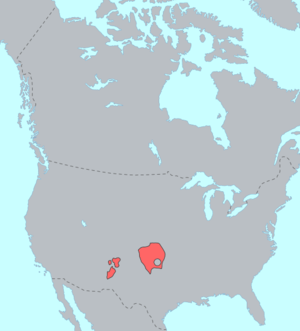Kiowa–Tanoan languages
| Kiowa–Tanoan Tanoan | |
|---|---|
| Geographic distribution: | central North America |
| Linguistic classification: | ? Aztec–Tanoan (hypothetical) Kiowa–Tanoan |
| Subdivisions: | |
| Distribution of Kiowa–Tanoan languages before European contact. The pueblo languages are at the left; the nomadic Kiowa at right. | |
Kiowa–Tanoan (also Tanoan–Kiowa or just Tanoan) is a family of languages spoken in New Mexico, Kansas, Oklahoma, and Texas.
Most of the languages – Tiwa (Taos, Picuris, Southern Tiwa), Tewa, and Towa – are spoken in the Pueblos of New Mexico (with one outlier in Arizona) and called collectively Tanoan, while Kiowa is spoken mostly in southwestern Oklahoma.
Languages
The Kiowa–Tanoan language family has seven languages in four branches:
| Kiowa–Tanoan |
| |||||||||||||||||||||||||||
Kiowa–Towa might form an intermediate branch, as might Tiwa–Tewa.
Name
Tanoan has long been recognized as a major family of Pueblo languages, consisting of Tiwa, Tewa and Towa. The inclusion of Kiowa into the family was at first controversial; the once nomadic Kiowa people of the Plains are culturally quite distinct from the Tiwa, Tewa, and Towa pueblos. However, it is now accepted that a Tanoan family without Kiowa would be paraphyletic, as any ancestor of the pueblo languages would be ancestral to Kiowa as well. Indeed, Kiowa may be closer to Towa than Towa is to Tiwa–Tewa. Thus technically Tanoan and Kiowa–Tanoan are synonyms. However, because of the cultural use of the name Tanoan, the more explicit term Kiowa–Tanoan is generally used for the language family.
Genealogical relations
The Kiowa–Tanoan family has been connected to the Uto-Aztecan family in a hypothetical Aztec–Tanoan proposal. Although undemonstrated, many linguists find this hypothesis to be promising.
Prehistory, archaeological perspectives
Historical phonology
The chart below contains the reconstructed consonants of the Kiowa–Tanoan proto-language as reconstructed by Hale (1967) based on consonant correspondences in stem-initial position.
The evidence for *ɡ comes from prefixes; *ɡ has not been found in stem-initial position and thus is in parentheses above. Hale also reconstructs the nasalization feature for nasal vowels. Vowel quality and prosodic features like vowel length, tone, and stress have not yet been reconstructed for the Kiowa–Tanoan family. However, Hale (1967) does give certain sets of vowel quality correspondences.
The following table illustrates the reconstructed initial consonants in Proto–Kiowa–Tanoan and its reflexes in the daughter languages.
As can be seen in the above table, a number of phonological mergers have occurred in the different languages. Cognate sets supporting the above are listed below:
Notes
Bibliography
Retrieved from : http://en.wikipedia.org/wiki/Kiowa%E2%80%93Tanoan_languages
